How has a growing world population affected food production?
World population is defined as the number of humans living on the earth at a given moment. The world’s population is now estimated to be around 7.7 billion people. According to an article by Max Roser, "Future Population Growth," the rate of growth of the world’s people reached its peak in the late 1960s, when the number was increasing about 2 percent each year. Since then, it has slowed to just 1 percent. Nevertheless, by the year 2060, one estimate made by the United Nations is that the Earth’s population will reach 10 billion people.
Iowan Norman Borlaug
Iowa has a special place in the story of world population growth. In the 1960s, agricultural scientists increased efforts to boost food population in developing countries that were experiencing rapid population increases that threatened to lead to food shortages and starvation. Iowa-born agronomist Norman Borlaug was an acknowledged leader of this effort that became known as The Green Revolution. Borlaug developed improved crop varieties adapted to the climates where they were grown that proved to be tremendously successful. He also persuaded government and the farmers themselves to promote the new seed. A Borlaug biography claims that the increases in food production that resulted saved an estimated one billion people from starvation. Borlaug was awarded the Nobel Peace Prize in 1970 for his efforts, the first time the award was given to someone in agriculture. Later, Borlaug helped to create the World Food Prize with headquarters in Des Moines to continue to recognize those who are helping to feed a hungry world.
Factors of World Population Growth
Two key factors in population growth are mortality and fertility. Mortality refers to the ages at which people die. As people live longer, the population increases. Improvements in education, medicine, food and living conditions have extended life expectancy, boosting the world population. Developing countries benefited during the last half of the 20th century from expanded medical services which led to longer and healthier lives for their people. It also helped to increase the number of people who need to be fed.
Fertility measures the average number of births per woman of child-bearing years. A critical factor here is not just the worldwide fertility rate but the rates in different parts of the world. Women in highly developed countries like the United States and Europe are having fewer children than they did fifty years ago. In contrast, the rates in some of the poorer countries of Africa and the Middle East continue to have more children. Droughts, wars and migrations have created emergency conditions when these countries cannot feed themselves but must rely on international assistance to prevent widespread starvation. Some developed countries now face a critical shortage of younger workers while other areas struggle to feed and educate increases in children.
Iowa's Role is Addressing a Rising World Population
Iowa enters into the global conversation in other ways as well. The demand for ethanol made from corn diverts a sizable portion of the crop each year from food to fuel. While it helps to raise prices for producers, it makes it more expensive for poorer countries to buy the corn their need for food. Scientists are now able to genetically modify crops to make them more productive and disease resistant. However, there are concerns about introducing some genetically modified crops when their long-term impacts are unknown.
Food production is an issue of vital concern to everyone. Iowa as a food producer is and will continue to be an important player in the discussions and implementation.
Supporting Questions
How has world population changed over time?
- S.J.Res.158 - A joint resolution designating October 21 through 27, 1990, as "World Population Awareness Week," June 16, 1989 (Document)
- NPR's "7 Billion: How Did We Get So Big So Fast?" October 31, 2011 (Video)
- "World Population" Growth Animation, March 26, 2015 (Video)
- United Nations' World Population Prospects Report, 2017 (Document)
How has food production changed over time to accommodate a growing population?
- Letter Correspondence between Mahatma Gandhi and George Washington Carver, February 24, 1929 to July 27, 1935 (Document)
- "Checking the Corn in Hills" in Jasper County, Iowa, May 1940 (Image)
- "GMOs Are Safe, But Don't Always Deliver On Promises, Top Scientists Say," May 17, 2016 (Audio)
- "Seeds Of Change: Mini Gardens Help Drive The Growth Of Food At Home," May 31, 2017 (Document)
- "Amid GMO Strife, Food Industry Vies For Public Trust In CRISPR Technology," October 25, 2017 (Audio)
How has a changing world population affected how land is used?
- "The Crop Outlook" Newspaper Article, June 30, 1906 (Document)
- Family Working on the Farm, between 1915 and 1923 (Image)
- "Recognize Iowa as Agricultural State" Manzanar Free Press Article, November 10, 1943 (Document)
- Kaestner Family at their Century Farm near Luzerne in Benton County, Iowa, August 8, 2016 (Image)
- Lush Soybean Field on Dean and Julie Folkmann's Hog Farm in Newhall, Iowa, August 8, 2016 (Image)
| Population and Land Use Source Set Teaching Guide |
| Printable Image and Document Guide |
S.J.Res.158 - A joint resolution designating October 21 through 27, 1990, as "World Population Awareness Week," June 16, 1989
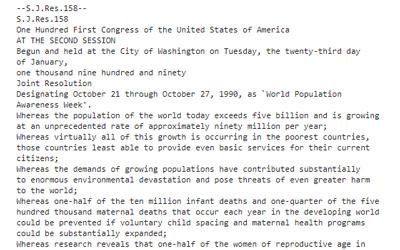
Description
This U.S. Senate joint resolution was introduced June 16, 1989, to designate Oct. 21-27, 1990, as World Population Awareness Week. The sponsor of this resolution was former Sen. John Kerry, a Democrat from Massachusetts. The legislation became a law October 25, 1990.…
NPR's "7 Billion: How Did We Get So Big So Fast?" October 31, 2011

Description
This report from National Public Radio shows that just over two centuries ago that the global population was 1 billion, but better medicine and improved agriculture has dramatically increased the world population. The United Nations is reported as predicting the world…
"World Population" Growth Animation, March 26, 2015
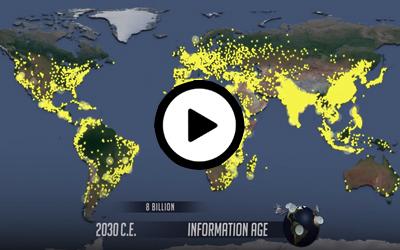
Description
This animated video shows human population grow from 1 C.E. to the present day. The video also shows the projected growth of the world's population — all in a matter of six minutes. Each dot represents 1 million people.
United Nations' World Population Prospects Report, 2017
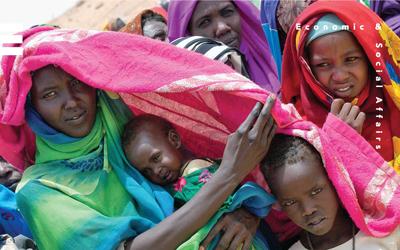
Description
This report from the Department of Economic and Social Affairs at the United Nations analyzes world population projects from 2017 to 2100. The first two pages of the report featured in this source focus on the summary and key findings by the UN department. …
Letter Correspondence between Mahatma Gandhi and George Washington Carver, February 24, 1929 to July 27, 1935

Description
The first letter is from George Washington Carver, notable American botanist, and Charlie Andrews, a close personal friend to Mahatma Gandhi. Gandhi had Andrews assist him in reaching out to Carver to inquire about the health of eating a vegan diet. Gandhi was working…
"Checking the Corn in Hills" in Jasper County, Iowa, May 1940
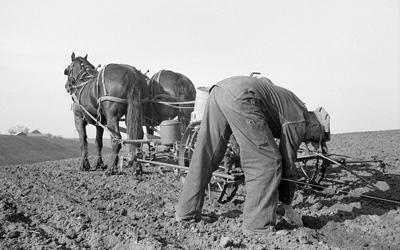
Description
The photograph, taken by John Vachon, shows a farmer behind a team of horses pulling a small planter behind them in May 1940. The farmer appears to be checking the corn to make sure it is correctly planting.
"GMOs Are Safe, But Don't Always Deliver On Promises, Top Scientists Say," May 17, 2016
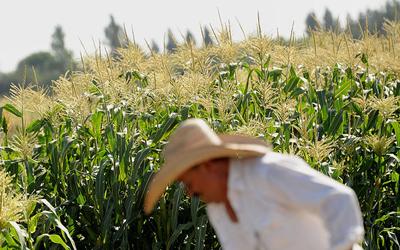
Description
This National Public Radio report, which was featured on "All Things Considered," focuses on the National Academy of Sciences' judgment that GMOs (genetically modified organisms) are safe to eat. But the group's latest report also brought up numerous economic and…
"Seeds Of Change: Mini Gardens Help Drive The Growth Of Food At Home," May 31, 2017
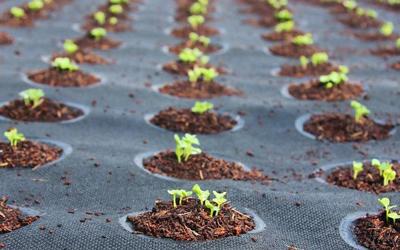
Description
This National Public Radio article focuses on the rising trend of the garden kit startup, Seedsheet. This company, based in Vermont, is a kind of "farm delivery" service that encourages growing a lot of food in a small amount of space.
"Amid GMO Strife, Food Industry Vies For Public Trust In CRISPR Technology," October 25, 2017
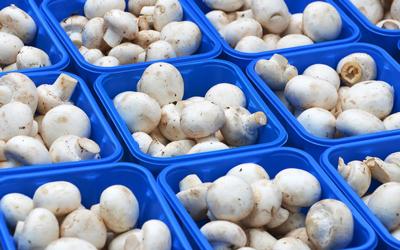
Description
This National Public Radio report focused on new gene-editing technology called Clustered Regularly Interspaced Short Palindromic Repeats, or CRISPR. Dozens of crops and livestock are expected to be developed with CRISPR, which is an emerging technique to…
"The Crop Outlook" Newspaper Article, June 30, 1906

Description
This article is from the Ottumwa Tri-Weekly Courier and was published June 30, 1906. It is about a report filed by the director of Agriculture in Iowa, J.R. Sage. The report speaks of the welcomed rain all of Iowa received the…
Family Working on the Farm, between 1915 and 1923
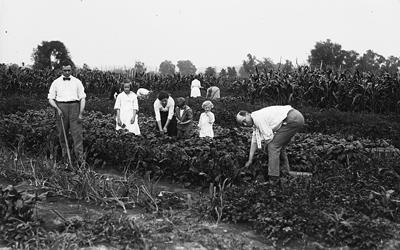
Description
This photograph shows a farm family tending to their crops on their farm between 1915 and 1923. There are several different crops being grown, as shown in this photo.
"Recognize Iowa as Agricultural State" Manzanar Free Press Article, November 10, 1943
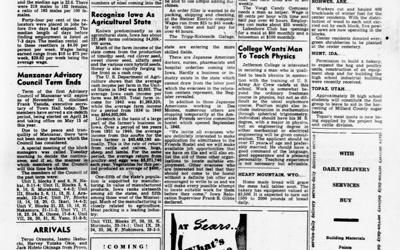
Description
This article about Iowa's state of agriculture was published in the Manzanar Free Press on November 10, 1943. According to the article, the average Iowa cash income per farm was $6,025 in 1942, while the national average was $2,685.
Kaestner Family at their Century Farm near Luzerne in Benton County, Iowa, August 8, 2016
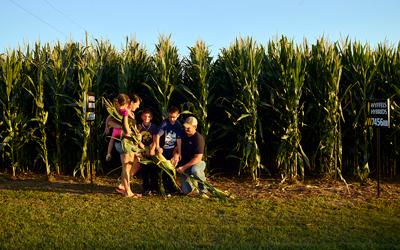
Description
This photograph by Carol Highsmith shows the Kaestner family at their Century Farm near Luzerne in Benton County. Their farm, located in eastern Iowa and dates back to 1915, now grows prize corn and soybeans and includes a thriving seed business.
Lush Soybean Field on Dean and Julie Folkmann's Hog Farm in Newhall, Iowa, August 8, 2016
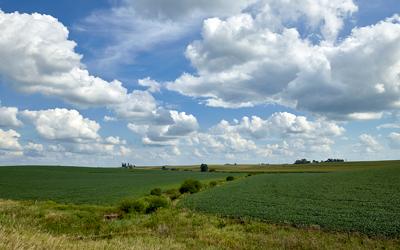
Description
This photograph shows the farmstead of the Folkmann family in Benton County, Iowa. As of 2016, the Folkmann hog farm has been in the family for 162 years. At any time, approximately 50 million hogs are being raised in the state with just over 3 million people. That is about…
Additional Resources
- Food Empowerment Project
This website is for the Food Empowerment Project, a vegan food justice organization that focuses on world issues related to food justice. Their work spotlights the abuse of animals on farms, the depletion of natural resources, unfair working conditions for produce workers and the unavailability of healthy foods in low-income areas. - Population Education
This website is part of "Population Education," a national program with a strong emphasis on curriculum and professional development for K-12 educators that focuses on human population issues. - Living History Farms
This online resource is a guide to Iowa's Living History Farms, an interactive outdoor history museum which educates, entertains and connects people of all ages to Midwestern rural life experiences. - Globalization 101
Globalization101.org is an Internet resource offered by the Levin Institute to promote a greater understanding of globalization. - World Food Prize
This website focuses on multiple aspects surrounding the World Food Prize and a number of its related events and programs. The World Food Prize is the foremost international honor recognizing the achievements of individuals who have advanced human development by improving the quality, quantity or availability of food in the world.
Iowa Core Social Studies Standards (7th Grade)
Listed below are the Iowa Core Social Studies content anchor standards that are best reflected in this source set. The content standards applied to this set are high school-age level and encompass the key disciplines that make up social studies for seventh-grade students.
| No. | Standard Description |
| SS.7.21. | Evaluate the push and pull factors involved in human population movement and patterns. |
| SS.7.22. | Explain how the relationship between the environmental characteristics of places and production of goods influences the spatial patterns of world trade. |
| SS.7.23. | Explain how global changes in population distribution patterns affect changes in land use in particular areas. |
| SS.7.27. | Analyze the role that Iowa plays in contemporary global issues. |